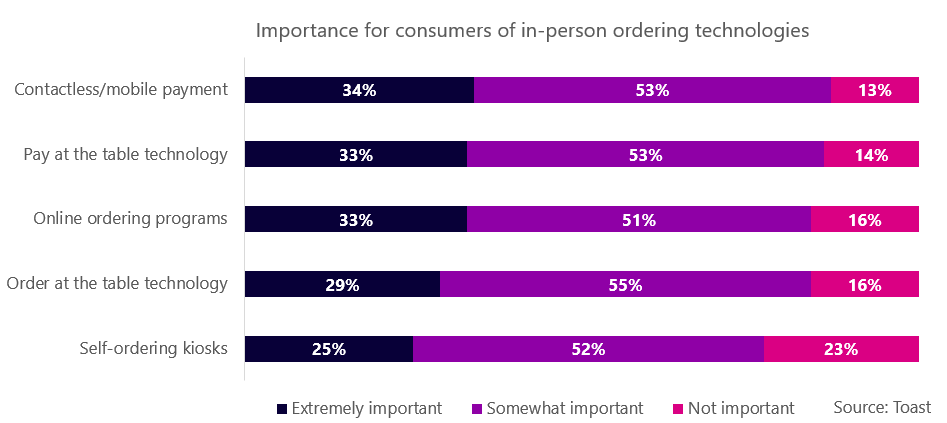Merchants in the Food & Beverage sector face numerous hurdles when it comes to accepting payments, from slow and inefficient processes to integration challenges, security, risks of mishandling cash, high turnover of staff / cost of training, and cost of payment acceptance. These complexities generally do not mix well with customers’ high expectations for fast, convenient, and seamless checkout experiences; and these difficulties further increase with legacy payment methods such as plastic cards, cash and paper cheques.
The rise of contactless payments in the industry has been helping merchants address some of these challenges, as it provides customers with a great experience, and enables increased flexibility on the merchant side.
Contactless payments are about 10 times faster than any other payment methods, reducing wait times, customer lines, improving the customer experience and satisfaction, and freeing up staff for other tasks. Combined, these effects lead to:
- Reduction of cost: greater speed of service, less Full-Time Equivalents (FTEs) required, refocus of staff’s effort on tasks creating value, and optimisation of space.
- Increase in revenue: enhanced convenience, improved consumer satisfaction creating repeat customers, greater turnover due to the increased speed of service, greater efficiency at peak times, and increased consumption.
Additionally, contactless payments perfectly accommodate two of the most challenging post-pandemic changes in consumer behaviour (as cited by industry professionals): concern about health and safety (56%) and greater demand for convenience (28%). They are also an actionable solution to the pervasive problem of understaffing, with restaurant owners using technology to fill the gap when understaffed, and accepting payments being the second most cited use case (35% of respondents), according to Square.
While the payment methods offered by merchants may not be a direct selection criterion for customers, they do influence their decision-making. Convenience is claimed to influence 26% of consumers, and 22% for a positive guest experience, both heavily influenced by the checkout process and availability of payment methods. Furthermore, 36% of consumers use a mobile wallet at least once a month to transact, climbing up to 48% for the most tech-savvy consumer segments. Therefore, some consumer segments will expect to be able to pay through contactless transactions. Offering contactless payments is now non-negotiable for businesses in the hospitality segment, and an answer to the high customer expectations regarding the integration of technology in the ordering and payment processes, as illustrated in this recent research by Toast, a cloud-based restaurant management solution provider:

The integration of contactless payments is bound to grow to answer customer’s expectations and will drive further evolutions of the checkout process. The reduction of reliance on dedicated POS devices (thanks to the popularisation of SoftPOS) enables smaller businesses to use smartphones or tablets as payment terminals, just with the download of an app. Another merchant innovation powered by contactless payments is self-service. Customers can conveniently complete their checkout without assistance from sales associates, while ensuring fast and smooth processes. This helps greatly reduce the need for staff, and better manage peak times, even enabling entirely staff-free operations with the automated distribution of items purchased.
Contactless is unquestionably a key component of face-to-face payments. According to Mastercard, over 66% of in-person transactions conducted globally on their network are now contactless, illustrating the high adoption among consumers worldwide. In an increasingly digitalised world, contactless payments are positioned as a true alternative to cash. Furthermore, the greater convenience experienced with low-value transactions increasingly seduces consumers, and contactless payments are gaining prominence for higher value payments as well. This is reflected in the rise of transaction limits set by regulators for contactless transactions. In the UK for example, the limit of £20 in 2012, was upped to £30 in 2015 and £100 in 2021, and there are now talks of the Financial Conduct Authority (FCA) increasing the limit over £100. Ceilings can even be lifted in the case of pass-through wallets (such as Apple Pay and Google Pay), for which the biometric identification reduces the risk associated with physical card-based contactless transactions.
On the other side of the world, Australia is considered a global leader in contactless payments. The country has one of the highest adoption rates of contactless transactions worldwide, driven by consumer preference for speed, convenience, and security, as well as widespread acceptance among merchants. Businesses must incorporate contactless payments intelligently into their overall payment acceptance and processing strategy, to realise the benefits from this innovation. Nonetheless, successfully integrating contactless solutions requires more than just technology, it demands a strategic approach that will ensure the customer experience is enhanced, optimizes transaction efficiency, reduces operational costs, and aligns with broader business goals. Edgar, Dunn & Company (EDC) can assist you in defining your current needs and future expectations, and build an optimised acceptance strategy for your business.
The content of this article does not reflect the official opinion of Edgar, Dunn & Company. The information and views expressed in this publication belong solely to the author(s).
Justine is an Associate Consultant in EDC’s Paris Office. Justine has worked on projects for payment processors, schemes and hardware providers in Europe, and MEA region. Justine has delivered projects on market sizing, competitive landscaping, market research and comparative analysis for a range of clients. Justine holds an MSc Management from Imperial College Business School and a Licence (BSc) in Law, Economics and Social Sciences from Université Panthéon Sorbonne. In her free time, Justine does yoga and enjoys all sorts of arts & crafts.
.webp)
%20(1).webp)

%20(1).webp)

.webp)


